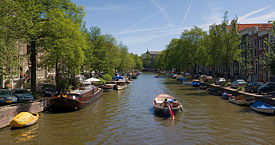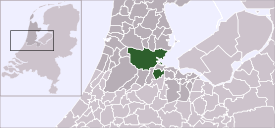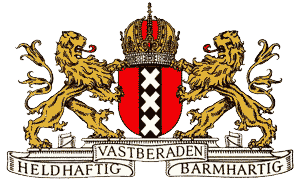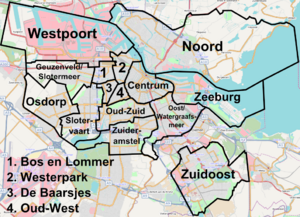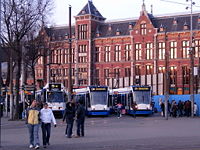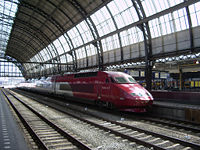Difference between revisions of "Amsterdam" - New World Encyclopedia
Keisuke Noda (talk | contribs) (import from wiki) |
m (Robot: Remove claimed tag) |
||
| Line 1: | Line 1: | ||
| − | + | ||
'''Bold text'''{{otheruses}} | '''Bold text'''{{otheruses}} | ||
<!-- Infobox begins —> | <!-- Infobox begins —> | ||
Revision as of 02:18, 2 April 2008
Bold text
- For other uses, see Amsterdam (disambiguation).
| Amsterdam | |||
| Canal houses alongside the Prinsengracht | |||
|
|||
| Nickname: Mokum | |||
| Motto: Heldhaftig, Vastberaden, Barmhartig (Valiant, Determined, Compassionate) |
|||
| Location of Amsterdam | |||
| Coordinates: {{#invoke:Coordinates|coord}}{{#coordinates:52|22|23|N|4|53|32|E|type:city | |||
|---|---|---|---|
| name= }} | |||
| Country | Netherlands | ||
| Province | North Holland | ||
| Government | |||
| - Mayor | Job Cohen (PvdA) | ||
| - Aldermen | Lodewijk Asscher Hennah Buyne Carolien Gehrels Tjeerd Herrema Maarten van Poelgeest Marijke Vos |
||
| - Secretary | Erik Gerritsen | ||
| Area [1][2] | |||
| - City | 219 km² (84.6 sq mi) | ||
| - Land | 166 km² (64.1 sq mi) | ||
| - Water | 53 km² (20.5 sq mi) | ||
| - Urban | 896 km² (345.9 sq mi) | ||
| - Metro | 1,896 km² (732 sq mi) | ||
| Population (January 1, 2006)[2][3] | |||
| - City | 743,027 | ||
| - Density | 4,459/km² (11,548.8/sq mi) | ||
| - Urban | 1,209,419 | ||
| - Metro | 2,191,259 | ||
| - Randstad | 6,659,300 | ||
| Time zone | CET (UTC+1) | ||
| - Summer (DST) | CEST (UTC+2) | ||
| Website: www.amsterdam.nl | |||
Amsterdam ▶ is the capital city of the Netherlands, located in the south of the province North Holland. The city was founded in the late 12th century as a small fishing village at the mouth of the river Amstel. The name Amsterdam literally means Amstel dam.[4] The historical centre with its concentric canals was largely built during the Dutch Golden Age in the 17th century. Amsterdam has more then 7500 protected monuments. Amsterdam has the largest historical citycentre from Europe. As of January 1, 2006 the city of Amsterdam has a population of 743,027 inhabitants and is by population size the largest city in the Netherlands. The urban area has a population of 1,209,419 inhabitants and is part of the conglomerate metropolitan area Randstad, with a population of 6,659,300 inhabitants.
Name
The first occurrence of Amsterdam in writing was in a Latin certificate of count Floris V in 1275: homines manentes apud Amestelledamme (English: people living near Amestelledamme).[5] The meaning of Amestelledamme is dam or dyke of the Amstel[4], where the name of the river Amstel can be dissected into ame meaning 'water' and stelle meaning 'dry ground'. The r from the current name was first used in 1282: Amestelredamme. In 1327 count William III used the form Aemsterdam, which best resembles the modern form Amsterdam.[5]
History
Amsterdam began as a fishing village in the late 12th century. According to legend, Amsterdam was founded by two Frisian fishermen, who landed on the shores of the Amstel in a small boat with their dog. The damming of the river Amstel gave it its name (in Dutch: Amstelredam "Dam in the Amstel", turned into Amsterdam in the course of time). The traditional founding of the city of Amsterdam is 27 October 1275, when the inhabitants living around the Amstel dam were granted freedom from paying the tolls associated with the locks and bridges of Holland. It was given city rights in 1300 or 1301. From the 14th century on, Amsterdam flourished, largely on the basis of trade with the cities of the Hanseatic League. In 1345 a Eucharistic miracle occurred near the Kalverstraat and Amsterdam would remain an important pilgrimage city until the Alteration to the protestant faith; today the Stille Omgang - a silent procession in civil dress - remains of the rich pilgrimage history.
In the 16th century, the Dutch rebelled against Philip II of Spain and his successors. The revolt escalated into the Eighty Years' War which ultimately led to Dutch independence and the imposition of Protestant Calvinism as de facto state religion. In 1578 the previously Catholic city of Amsterdam joined the revolt and all churches were confiscated for the reformed Protestant worship. After the break with Spain, the Dutch Republic became known for its relative religious tolerance, except towards Catholics who had to worship secretly. Jews from Spain and Portugal, prosperous merchants from Antwerp (economic and religious refugees from the part of the Low Countries still controlled by Spain), and Huguenots from France (persecuted for their religion) sought safety in Amsterdam.
The 17th century is considered Amsterdam's "Golden Age". In the early 17th century Amsterdam became one of the wealthiest cities in the world. Ships sailed from Amsterdam to the Baltic Sea, North America, Africa and present-day Indonesia and Brazil, and formed the basis of a worldwide trading network. Amsterdam's merchants had the biggest share in the VOC and WIC. These companies acquired the overseas possessions which formed the seeds of the later Dutch colonies. Amsterdam was the most important point for the trans-shipment of goods in Europe, and it was the leading financial centre of the world. Amsterdam's stock exchange was the first to trade continuously.
The 18th and early 19th centuries saw a decline in Amsterdam's prosperity. The wars of the Dutch Republic with England (see Anglo-Dutch Wars) and France took their toll on Amsterdam. During the Napoleonic Wars, Amsterdam's fortunes reached their lowest point. However, with the establishment of the Kingdom of the Netherlands in 1815, things slowly began to improve. In Amsterdam new developments were started by people like city planner Samuel Sarphati, who found their inspiration in Paris.
The end of the 19th century is sometimes called Amsterdam's second Golden Age. New museums, a train station, and the Concertgebouw were built. At this time the Industrial Revolution reached Amsterdam. The Amsterdam-Rhine Canal was dug to give Amsterdam a direct connection to the Rhine, and the North Sea Canal to give the port a shorter connection to the North Sea. Both projects improved communication with the rest of Europe and the world dramatically. Joseph Conrad gives a brief description of Amsterdam, seen from the sea at this period, in The Mirror of the Sea (1906). In 1924 the Roman Catholic Church of the Netherlands hosted the International Eucharistic Congress in Amsterdam, and numerous Catholic prelates visited the city, where numerous festivities were held in churches and stadiums; Catholic processions on the public streets however were still forbidden under law at the time.
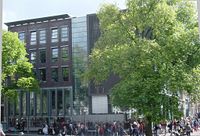
Shortly before the First World War the city began expanding and new suburbs were built. During the war, the Netherlands remained neutral. Amsterdam suffered a food shortage, and heating fuel became scarce. The shortages sparked riots in which several people were killed.
Germany invaded the Netherlands on 10 May 1940, taking control of the country after five days of fighting. The Germans installed a Nazi civilian government in Amsterdam that cooperated in the persecution of Jews. However, a minority of people in Amsterdam helped the Jews in hiding and suffered persecution themselves in doing so. More than 103,000 to 105,000 Jews were deported from the Netherlands to concentration camps, of whom perhaps the most famous was a young German girl, Anne Frank. Only 5,000 Dutch Jews survived the war. In the last months of the war, communication with the rest of the country broke down, and food and fuel became scarce. Many inhabitants of the city had to travel to the countryside to collect food. Dogs, cats and raw sugar beets were consumed to stay alive. Most of the trees in Amsterdam were cut down for fuel, and all the wood was taken from the apartments of the Jewish people who were deported.
Coat of arms
The coat of arms of Amsterdam is composed of several historical elements. First and centre are three St Andrew's crosses, aligned in a vertical band on the city's shield. Historians believe they represent the three dangers which have traditionally plagued the city: flood, fire, and pestilence. Second is the Imperial Crown of Austria, awarded to the city in 1489 by Maximilian I, Holy Roman Emperor, out of gratitude for services and loans. His crown was a sign of imperial protection and it acted as a seal of approval for Amsterdam's merchants abroad. The Westertoren (tower of the Westerkerk) is topped by the selfsame imperial crown. The lions date from the 16th century, when the city was part of one of the first republics in the world, the Repubic Of The Seven Provinces. Last came the city's official motto: Heldhaftig, Vastberaden, Barmhartig ("Valiant, Determined, Compassionate"), bestowed on the city by Wilhelmina van Oranje Nassau, Queen Wilhelmina of The Royal Kingdom of The Netherlands in 1947, in recognition of the city's bravery during World War II. The current design of the flag of Amsterdam is based on the coat of arms.
Capital
Although Amsterdam is officially designated as the capital of the Netherlands, it has never been (save a brief period between 1808 and 1810) the seat of the supreme court, government, or parliament of the Netherlands, which are all located at The Hague. Amsterdam is also not the capital of the province in which it is located, North Holland, whose capital is located at Haarlem.
City government
As all Dutch municipalities, Amsterdam is governed by a mayor, aldermen, and the municipal council. However, unlike most other Dutch municipalities, Amsterdam is subdivided into fifteen stadsdelen (boroughs), a system that was implemented in the 1980s to improve local governance. The stadsdelen are responsible for many activities that previously had been run by the central city. Fourteen of these have their own council, chosen by a popular election. The fifteenth, Westpoort, covers the harbour of Amsterdam, has very few inhabitants, and is governed by the central municipal council. Local decisions are made at borough level, and only affairs pertaining to the whole city, such as major infrastructure projects, are handled by the central city council.
Geography
Urban area
The city of Amsterdam is located on the banks of the rivers Amstel and Schinkel, and the bay IJ. Several parts of the city and of the urban area are polders, recognisable by their postfix -meer meaning 'lake', such as Aalsmeer, Bijlmermeer, Haarlemmermeer, and Watergraafsmeer. The urban area includes the municipalities: Aalsmeer, Amsterdam, Amstelveen, Diemen, Haarlemmermeer, Ouder-Amstel, Uithoorn, and Waterland. The size of the entire urban area is 896.96 km², whereof 718.03 km² is land.[2] As of January 1, 2006 the urban area has a population of 1,209,419 inhabitants.[2]
Metropolitan area
The metropolitan area consists of the urban area, its satellite cities, and the intervening rural land that is socio-economically connected to Amsterdam. This includes the municipalities: Aalsmeer, Almere, Amsterdam, Amstelveen, Beverwijk, Blaricum, Bloemendaal, Bussum, Castricum, Diemen, Haarlem, Haarlemmerliede, Haarlemmermeer, Heemstede, Heemskerk, Hilversum, Huizen, Laren, Muiden, Naarden, Oostzaan, Ouder-Amstel, Purmerend, Uitgeest, Uithoorn, Velsen, Waterland, Weesp, Wijdemeren, Wormerland, and Zaanstad. The total size of the metropolitan area is 1,896.97 km², whereof 1,447.36 km² is land.[2] As of January 1, 2006 the metropolitan area has a population of 2,191,259 inhabitants.[2] Amsterdam is part of the conglomerate metropolitan area Randstad, with a total population of 6,659,300 inhabitants.[3]
Climate
Amsterdam enjoys a moderate temperate climate, with the weather patterns being strongly influenced by Amsterdam's proximity to the North Sea to the west and its prevailing north-western winds and gales. Winter temperatures are mild: on average above freezing, although frosts are not uncommon during spells of easternly or northeasternly winds blowing in from the inner European continent, i. e. from Scandinavia, Russia and even Siberia. Summers are warm but rarely hot. Days with measurable precipitation are common, but still Amsterdam averages less than 760 mm of precipitation annually. Most of it falls as protracted drizzle or light rain. But the occasional Western storm may bring a lot of water at once, and all of it has to be pumped out to higher ground and to the seas around the city. These bodies of water make cloudy and damp days common, particularly in cooler months, October through March.
| Month | January | February | March | April | May | June | July | August | September | October | November | December | Year |
|---|---|---|---|---|---|---|---|---|---|---|---|---|---|
| Avg high °C (°F) | 5.4 (41.7) | 6.0 (42.8) | 9.2 (48.6) | 12.4 (54.3) | 17.1 (62.8) | 19.2 (66.6) | 21.4 (70.5) | 21.8 (71.2) | 18.4 (65.1) | 14.1 (57.4) | 9.2 (48.6) | 6.5 (43.7) | 13.4 (56.1) |
| Avg low °C (°F) | 0.5 (32.9) | 0.2 (32.4) | 2.4 (36.3) | 4.0 (39.2) | 7.8 (46.0) | 10.4 (50.7) | 12.5 (54.5) | 12.3 (54.1) | 10.2 (50.4) | 7.0 (44.6) | 3.9 (39.0) | 1.9 (35.4) | 6.1 (43.0) |
| Source: [1] | |||||||||||||
Economy
Amsterdam is the financial and business capital of the Netherlands and one of the most important cities in Europe in which to do business. Many large Dutch corporations and banks have their headquarters in Amsterdam, including ABN Amro, Heineken, ING Group, Ahold, Delta Lloyd Group and Philips. KPMG International's global headquarters is located in nearby Amstelveen, as is the European headquarters of Cisco Systems.
Though many subsidiaries are located along the old canals, more and more companies decide to move to a newly built office tower outside the city centre. The South Axis (Dutch: Zuidas) is increasingly a banking area, and is intended to become the new business-face of the Netherlands. There the recently expanded World trade centre also has its location.
The Amsterdam Stock Exchange (AEX) is part of Euronext, and is the world's oldest stock exchange. It still is one of the most important in Europe.
Demography
Template:Demography 12col
In the 16th and 17th century non-Dutch immigrants to Amsterdam were mostly Huguenots, Flemings, Sephardi Jews and Westphalians. Hugenots came after 1685's Edict of Fontainebleau, while the Flemish Protestants came during the Eighty Years' War. The Westphalians came to Amsterdam mostly for economic reasons.
The first mass immigrants were people from Indonesia, who came to Amsterdam after the independence of the Dutch East Indies in the 1940s and 1950s. In the 1960s guest workers from Turkey, Morocco , Italy and Spain migrated to Amsterdam. After the independence of Suriname in 1975 a large wave of Surinamese settled in Amsterdam, mostly in the Bijlmer area. Other immigrants come from Europe and North America. In the seventies and eighties many 'old' Amsterdammers moved to 'new' cities like Almere and Purmerend, prompted by third planological bill. Young professionals and artists moved into the 19th century neighbourhoods the Pijp and the Jordaan abandoned by these Amsterdammers. The non-Western immigrants settled mostly in the social housing projects in Amsterdam-West and the Bijlmer. Non-Western immigrants make up 34% of the population.[7]
Education
Amsterdam has two universities: the University of Amsterdam (Universiteit van Amsterdam), and the Free University (Vrije Universiteit). Other institutions for higher education include an art school, De Rietveldacademie, the Hogeschool van Amsterdam and the Amsterdamse Hogeschool voor de Kunsten. Amsterdam's International Institute of Social History is one of the world's largest documentary and research institutions concerning social history, and especially the history of the labour movement. Amsterdam's Hortus Botanicus, founded in the early 1600s, is one of the oldest botanical gardens in the world, with many old and rare specimens, amongst them the coffee plant that served as the parent for the entire coffee culture in Central and South America.
Amsterdam is thought to have excellent primary schools. Some of these schools base their teachings on particular pedagogic theories like the various Montessori schools. Many however are based on religion. This used to be primarily Roman Catholicism and various Protestant denominations, but with the influx of Muslim immigrants there is a rise in the number of Muslim schools. In addition to these schools based on distinct beliefs there are public schools.
The same goes for secondary education. Amsterdam is noted for having 3 independent grammar schools (Dutch: gymnasia), the Vossius Gymnasium, Barlaeus Gymnasium and St. Ignatius Gymnasium, where a classical curriculum including Latin and classical Greek is taught. Though believed until recently by many to be an anachronistic and elitist concept that would soon die out, the gymnasia have recently experienced a revival.
Transportation
Amsterdam is a major hub of the highway system of the Netherlands by design.[8] Dutch freeways (comparable to US interstate and UK motorway roads) numbered one through eight were originally planned to originate from Amsterdam in 1932.[8] Complications, like the outbreak of the Second World War and shifting priorities led to the current situation, where roads A1, A2, and A4 originate from Amsterdam according to the original plan. These connect the capital with Germany (via Apeldoorn), Utrecht and Leiden respectively. Cancelled road A3 would connect Amsterdam with Rotterdam via Gouda, but conservation of the Groene Hart was deemed more important in 1970. Road A8, leading north to Zaandam and Ringroad A10 were opened between 1968 and 1974. [9] Besides the A1, A2, A4 and A8, several freeways, such as the A7 and A6, mainly carry traffic bound for Amsterdam, but terminate at one of the former.
The A10 Ringroad surrounding the city connects Amsterdam with the Dutch national network of freeways. Interchanges on the A10 allow cars to enter the city by transferring to one of the eighteen city roads, numbered s101 through s118. These city roads are regional roads without grade separation, and sometimes without a central reservation. Most are accessible by cyclists. The s100 is called the centrumring, a smaller ringroad circumnavigating the city centre.
In the city centre, driving a car is discouraged. Parking fees are steep and a great number of streets are closed to cars or are one-way.[10] The local government sponsors carsharing and carpooling initiatives such as Autodelen and Meerijden.nu.[11]
Public transport in Amsterdam, operated by Gemeentelijk Vervoerbedrijf, Connexxion and Arriva consists of bus and tram lines. Amsterdam has three metro lines, a fourth line, the North/South line, being under construction. Several ferries exist, operating for pedestrians and cyclists across the IJ free of charge.
Amsterdam is known as one of the most bicycle-friendly cities in the world and is a centre of bicycle culture. Most main streets have bike paths. Bike racks are ubiquitous throughout the city. There are about 700,000 bicycles in the city. Each year, about 80,000 of them are stolen and 25,000 end up in the canals.
Amsterdam is served by eight stations of the Nederlandse Spoorwegen (Dutch Railways).[12]. Five are intercity stops: Sloterdijk, Zuid, Amstel, Bijlmer ArenA and Amsterdam Centraal. Many other stations exist in the Amsterdam urban area.
Eurolines has coaches from Amsterdam to destinations all over Europe.
Amsterdam Centraal is an international train station. From the station there are regular sevices with destinations in Belgium, France, Germany, and Switzerland. Among these trains are international trains of the Nederlandse Spoorwegen and the Thalys, CityNightLine, and InterCityExpress.[13]
Amsterdam Schiphol Airport is less than 20 minutes by train from Amsterdam Central Station. It is the biggest airport in the Netherlands, the fourth largest in Europe and the tenth largest in the world. It handles about 42 million passengers a year and is home base to KLM, since 2004 part of Air France-KLM. Schiphol is the third busiest airport in the world measured by international passengers.
Culture
Tourist attractions
Amsterdam has more then 7500 protected monuments.
Amsterdam has the largest historical citycentre from Europe.
Amsterdam is noted for many outstanding museums, including the Rijksmuseum, the Stedelijk Museum, the Rembrandt House Museum, and its world-class symphony orchestra, the Concertgebouworkest, the home base of which is the Concertgebouw. The Van Gogh Museum houses the largest collection of Van Gogh's paintings and drawings in the world. Anne Frank House is also a popular tourist attraction.
Amsterdam is also famous for its red-light district, de Wallen. Window prostitution is legal in the Netherlands at specific places. The red-light district is located in the centre of the city along major canals and is clearly marked on maps.
Centred around the Wallen, but also elsewhere in the city, coffee shops sell cannabis. This is not completely legal but is tolerated when small quantities of cannabis (up to 5 grams) are involved.
Sports
Amsterdam is the home town of Eredivisie club Ajax. Its home base is the modern stadium Amsterdam ArenA, located in the south-east of the city.
In 1928, Amsterdam hosted the Games of the IXth Olympiad. The Olympic Stadium built for the occasion has been completely restored and is now used for cultural and sporting events.
Amsterdam also is home to a famous ice rink, the Jaap Eden baan. The Amstel Tijgers play in this arena in the Dutch ice hockey premier league. In speed skating many international championships have been fought in the 400-meter lane of this ice rink.
The city also has a baseball team, the Amsterdam Pirates, who play in the Dutch Major League. There are three field hockey teams, Amsterdam, Pinoké and Hurley, who play their matches around the Wagener Stadium. These teams are often referred to as playing in Amsterdam; however, all of them (even Amsterdam) play their matches in the neighbouring city of Amstelveen. There is also a basketball team, the Amsterdam Astronauts, who compete in the Dutch premier division and play their games in the Sporthallen Zuid, near the Olympic Stadium.
Since 1999 the city of Amsterdam has honoured its best sportsmen and -women at the Amsterdam Sports Awards. Boxer Raymond Joval and field hockey midfielder Carole Thate were the first to receive the awards in 1999.
ReferencesISBN links support NWE through referral fees
- ↑ Kerncijfers voor Amsterdam en de stadsdelen, 1 januari 2006. www.os.amsterdam.nl. Research and Statistics Service, City of Amsterdam. Retrieved 2007-04-04.
- ↑ 2.0 2.1 2.2 2.3 2.4 2.5 Area, population density, dwelling density and average dwelling occupation, 1 January 2006. www.os.amsterdam.nl. Research and Statistics Service, City of Amsterdam. Retrieved 2007-04-04.
- ↑ 3.0 3.1 Randstadmonitor 2006. www.regio-randstad.nl. Regio Randstad (January 2007). Retrieved 2007-04-04.
- ↑ 4.0 4.1 Encyclopædia Britannica Eleventh Edition, Vol 1, p896-898.
- ↑ 5.0 5.1 Berns, Jan and Daan, Jo (1992). Hij zeit wat. De Amsterdamse volkstaal (in Dutch). The Hague: BZZTôH, p. 91. ISBN 90-629-756-9.
- ↑ Source: 2005 a record year for the Anne Frank House
- ↑ Bevolking naar herkomstgroepering, 1 januari 2001-2006 (in Dutch). Dienst Onderzoek en Statistiek (Research and Statistics Service). Retrieved 2007-04-19.
- ↑ 8.0 8.1 Autosnelweg.nl - Geschiedenis Autosnelwegen in Nederland (in Dutch). Autosnelweg.nl. Retrieved 2007-04-19.
- ↑ Autosnelweg.nl - Geschiedenis Autosnelwegen in Nederland (in Dutch). Autosnelweg.nl. Retrieved 2007-04-19.
- ↑ Amsterdam Fietst (in Dutch). Retrieved 2007-04-19.
- ↑ Amsterdam.nl - Auto (in Dutch). Retrieved 2007-04-19.
- ↑ Stationsweb-Noord Holland (in Dutch). Retrieved 2007-04-19.
- ↑ Bestemmingen. NS internationaal.nl. Nederlandse Spoorwegen. Retrieved 2007-04-19.
External links
- Amsterdam.nl (Dutch)
- I amsterdam
- Travel guide to Amsterdam from Wikitravel
- Amsterdam City guide for Google Earth
-
- Mapping from Multimap or GlobalGuide or Google Maps
- Satellite image from WikiMapia
- Mapping from OpenStreetMap
Template:Province North Holland
1985 Athens · 1986 Florence · 1987 Amsterdam · 1988 West Berlin · 1989 Paris · 1990 Glasgow · 1991 Dublin · 1992 Madrid · 1993 Antwerp · 1994 Lisbon · 1995 Luxembourg City · 1996 Copenhagen · 1997 Thessaloniki · 1998 Stockholm · 1999 Weimar · 2000 Reykjavík · Bergen · Helsinki · Brussels · Prague · Kraków · Santiago de Compostela · Avignon · Bologna · 2001 Rotterdam · Porto · 2002 Bruges · Salamanca · 2003 Graz · 2004 Genoa · Lille · 2005 Cork · 2006 Patras · 2007 Luxembourg City and Greater Region · Sibiu · 2008 Liverpool · Stavanger · 2009 Linz · Vilnius · 2010 Essen · Pécs · Istanbul · 2011 Turku · Tallinn · 2012 Maribor · Guimarães ·
1896: Athens • 1900: Paris • 1904: St. Louis • 1908: London • 1912: Stockholm • 1920: Antwerp • 1924: Paris • 1928: Amsterdam • 1932: Los Angeles • 1936: Berlin • 1948: London • 1952: Helsinki • 1956: Melbourne • 1960: Rome • 1964: Tokyo • 1968: Mexico City • 1972: Munich • 1976: Montreal • 1980: Moscow • 1984: Los Angeles • 1988: Seoul • 1992: Barcelona • 1996: Atlanta • 2000: Sydney • 2004: Athens • 2008: Beijing • 2012: London
This article incorporates text from the Encyclopædia Britannica Eleventh Edition, a publication now in the public domain.
be-x-old:Амстэрдам
af:Amsterdam (Nederland) am:አምስተርዳም ang:Amsterdam ar:أمستردام roa-rup:Amsterdam frp:Amsterdam az:Amsterdam bn:অ্যামস্টারডাম bs:Amsterdam br:Amsterdam bg:Амстердам ca:Amsterdam cv:Амстердам cs:Amsterdam cy:Amsterdam da:Amsterdam de:Amsterdam arc:ܐܡܣܬܪܕܡ et:Amsterdam el:Άμστερνταμ es:Ámsterdam eo:Amsterdamo eu:Amsterdam fa:آمستردام fr:Amsterdam fy:Amsterdam ga:Amstardam gd:Amsterdam gl:Ámsterdam - Amsterdam ko:암스테르담 hy:Ամստերդամ hi:एम्सटर्डम hr:Amsterdam io:Amsterdam ilo:Amsterdam, Nederlandia id:Amsterdam ia:Amsterdam is:Amsterdam it:Amsterdam he:אמסטרדם ka:ამსტერდამი csb:Amsterdam sw:Amsterdam la:Amstelodamum lv:Amsterdama lb:Amsterdam lt:Amsterdamas lij:Amsterdam li:Amsterdam hu:Amszterdam mk:Амстердам ms:Amsterdam na:Amsterdam nl:Amsterdam nds-nl:Amsterdam ja:アムステルダム no:Amsterdam nn:Amsterdam nov:Amsterdam oc:Amsterdam nds:Amsterdam pl:Amsterdam pt:Amsterdã ro:Amsterdam qu:Amsterdam ru:Амстердам sq:Amsterdami scn:Amsterdam simple:Amsterdam sk:Amsterdam sl:Amsterdam sr:Амстердам sh:Amsterdam fi:Amsterdam sv:Amsterdam ta:ஆம்ஸ்டர்டம் th:อัมสเตอร์ดัม vi:Amsterdam tg:Амстердам tr:Amsterdam udm:Амстердам uk:Амстердам vo:Amsterdam diq:Amsterdam zea:Amsterdam zh:阿姆斯特丹
Credits
New World Encyclopedia writers and editors rewrote and completed the Wikipedia article in accordance with New World Encyclopedia standards. This article abides by terms of the Creative Commons CC-by-sa 3.0 License (CC-by-sa), which may be used and disseminated with proper attribution. Credit is due under the terms of this license that can reference both the New World Encyclopedia contributors and the selfless volunteer contributors of the Wikimedia Foundation. To cite this article click here for a list of acceptable citing formats.The history of earlier contributions by wikipedians is accessible to researchers here:
The history of this article since it was imported to New World Encyclopedia:
Note: Some restrictions may apply to use of individual images which are separately licensed.
